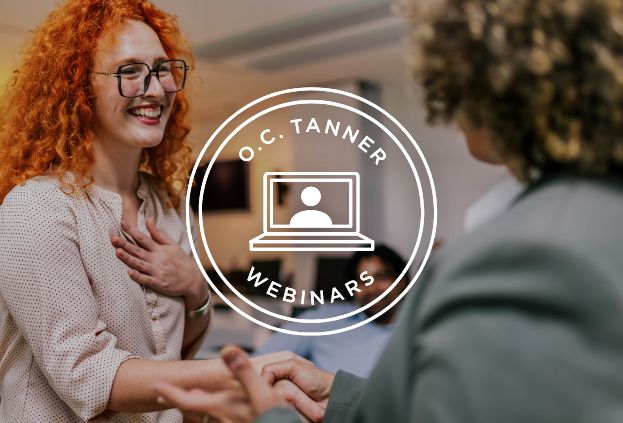Common Mistakes in Employee Recognition Programs at Large Companies
A structured employee recognition program can boost employee engagement, accelerate performance, and build a thriving work culture. But even with a program in place, can recognition go wrong? The answer is, of course, yes—especially at large companies when you're appreciating at scale.

Updated on
March 17, 2025
17
March
2025
Many large organizations often make mistakes—some big, some small—that undermine the effectiveness of their recognition strategies. Let’s take a look at some of the most common recognition mistakes we see and offer you some ideas on how to avoid them.
9 Common Employee Recognition Mistakes
Lack of integration
One of the most common employee recognition program mistakes we see is when companies haven’t taken the time to fully integrate recognition capabilities into the tools their employees use every day. When we say integrated, we mean seamless, easy, and intuitive. Employees shouldn’t have to leave their preferred workflow to give and receive recognition.
Organizations that create exceptional company cultures ensure that recognition is embedded into their culture. This type of highly integrated recognition has a powerful impact on organizations.
When recognition is integrated, it happens frequently for a variety of accomplishments, large and small, and comes from both leaders and peers. It’s personalized for the individual, seen across the organization, and the tools to give it are updated often.
Culture Cloud, for example, is a powerful recognition platform designed for large companies that integrates seamlessly with many of the apps your employees use every day, such as Teams, Slack, Outlook, Sharepoint, and many more.

Infrequent recognition
Many organizations save their employee recognition for a once-a-year event, like Employee Appreciation Day. And when it comes to budgeting, some spend too little, often on small, generic trinkets, while others spend extravagantly—but no more effectively—on cash incentives, gift cards, or awards.
Research on gift-giving shows expensive, infrequent gifts do not have the long-term impact one might expect. Smaller gestures given more often, over time, are much more meaningful and valued—especially if they’re personalized. The same proves true with employee recognition.

Frequent, tailored recognition experiences spread throughout the year have a larger, more lasting impact on morale and workplace culture than singular company-wide, all-employee events, no matter how much organizations spend.
The Harvard Business Review reports, “According to the data we collect on leaders across industries, every measure of morale, productivity, performance, customer satisfaction, and employee retention soars when managers regularly provide recognition. And, yet, there are many leaders out there who fail to do it frequently or skillfully.”
Employee recognition should be an ongoing process rather than a one-time event. Frequent recognition creates a culture of appreciation and reinforces positive attitudes consistently across the organization.
Generic appreciation
One common mistake is offering generic recognition without clearly specifying the reason behind it. General statements like "good job" or "great work" lack the necessary detail to help employees feel truly appreciated for their contribution.
Instead, recognition should be specific, detailing the particular achievements and work that deserve acknowledgment. Here are some employee recognition prompts to get you started.
Providing specific feedback not only improves fulfillment, but it also helps employees understand what they did well and encourages them to continue making great work. This is especially true at large companies where employees may have a harder time feeling connected to company leadership, values, and goals.

Lack of connection
Every recognition moment is an opportunity to connect the experience to your organization’s purpose, mission, and values. Linking great work to the company's mission helps employees understand the significance of their contributions. This reinforces how they fit into the overall success of the organization.
By reinforcing the connection between individual achievements and organizational objectives, employees are more likely to feel valued and fulfilled. This type of intentional recognition is essential to building a stellar work culture.
Forgetting recognition preferences
Not all employees have the same preferences when it comes to appreciation. While some may appreciate public recognition, others might prefer private recognition or tangible rewards. It is crucial to understand personal preferences and reward employees accordingly.
Regularly seeking feedback and conducting surveys can provide insights into the types of recognition that resonate most with employees, allowing you to customize your program and make it more effective.
Lack of authenticity
Employee recognition should not feel transactional or forced. Yet, all too often this still happens in today’s workplace.
Make the recognition personal. Just as you get to know about your employees’ preferences for recognition moments, you should seek to truly know them as people and what they value. Add sincere touches to their recognition moments that help them know you’re celebrating what they specifically bring to the team.

Gallup notes that “the most effective recognition is honest, authentic and individualized to how each employee wants to be recognized.”
Every recognition moment should be fully personalized for each employee, which can help them feel seen and valued.
Impersonal recognition
Another common mistake is leaving recognition responsibility solely on HR or upper management. Effective employee recognition programs require active involvement from managers and supervisors.
Learning how to properly recognize an employee is critical to a manager’s success—to build trust, loyalty, and engagement.
Managers have direct interactions with their team members, making them the best person to observe and appreciate great work. When managers actively participate in the recognition process, it strengthens the relationship between employees and their supervisors and reinforces the importance of recognition throughout the organization.
Dropping a gift on someone’s desk when they’re not around is impersonal and ineffective. You don’t have to interrupt their whole day, but employees—and their coworkers—should clearly know when they are being celebrated.
Invite the larger team to participate. If the person giving or receiving the award isn’t in an office, share virtual recognition with an eCard or send something to them in the mail. You can still gather coworkers and recognize great work over a video call.

Unclear criteria for rewards
Another problem with employee recognition programs is not having any specific criteria for recognition.
On the flip side of frequent recognition is the fact that your rewards programs can become random and meaningless if you recognize anything and everything. This can also be an opportunity to set the standard for great work at your organization and let employees know what to aspire to.
If the criteria for recognition and rewards is unclear, it can lead to confusion and frustration among employees. Organizations should clearly communicate the criteria, expectations, and guidelines for recognition to ensure fairness and transparency.
Sharing success stories and celebrating achievements across the organization creates a positive and supportive work environment.
Lack of training
This should be obvious, but one easy, crucial step is often overlooked:
Simply take the time to train your people.
To create a truly exceptional work culture, organizations should train leaders and all team members about the role of recognition, including:
- Why recognition matters
- How to personalize recognition in a meaningful way
- Why recognition is important for both large and small accomplishments
- Why recognition should be a priority
- How to give recognition intentionally
Companies should emphasize how to give holistic, personalized recognition, focusing on the impact of recognition and providing guidance for creating meaningful recognition moments for all employees.

Integrated recognition makes a difference
Through the years, when it comes to bad recognition practices, we’ve heard it all. Stories of managers who mispronounced employee names, recognized the wrong anniversary year, or confused employees with a random, unclear note left on their desk.
But, what we’ve seen much more of are incredible success stories and thriving work communities where happy employees take the time to appreciate each other with sincerity and ease. Stories of connection, camaraderie, teamwork, and belonging.
Your recognition program is a powerful tool. Above all, keep it real. Keep it genuine. And watch your people thrive.
See how Culture Cloud can help you build a strong workplace culture and improve business outcomes.



